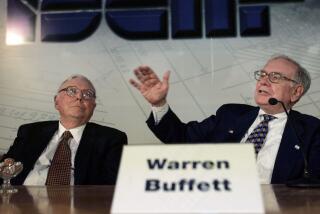John Nash, ‘A Beautiful Mind’ inspiration, and wife die in N.J. car crash

The barefoot man in mismatched plaids roamed for years through Princeton University’s math building, muttering to himself. In empty classrooms, the “Phantom of Fine Hall,” as he was known, scribbled mysterious equations and strange revelations.
He was a solitary figure, tormented by paranoia and subject to strange delusions. He once declined an appointment to the faculty at the University of Chicago, saying he was about to be named Emperor of Antarctica.
But John Forbes Nash Jr. was also a genius, a Nobel Prize winner who transformed economics and was known as one of the greatest mathematicians of his time.
The inspiration for Ron Howard’s 2001 Oscar-winning film “A Beautiful Mind,” he eventually recovered from his devastating illness, defying a common misconception about schizophrenia.
Nash, 86, and his wife, Alicia, 82, died Saturday in a traffic accident on the New Jersey turnpike. The taxi in which they were passengers hit a guardrail near Monroe Township, a spokesman for the New Jersey State Police said.
While Nash was famous among mathematicians for sophisticated solutions to a variety of problems involving algebraic geometry and partial differential equations, he was more widely known for his work in economics.
His 1994 Nobel Prize in economics was for his contributions to game theory, a discipline that has become fundamental to the study of the field and a crucial aid in high-stakes contests such as arms talks, trade negotiations, and elections.
It was a concept he laid out in his doctoral thesis when he was just 21.
His paper was only 27 pages – and “very generously double-spaced,” his friend and Princeton colleague Harold W. Kuhn joked to a Nobel seminar in 1994.
But the implications of what came to be called “the Nash equilibrium” were huge.
Game theory had emerged in the 1940s as the creation of mathematician John von Neumann and economist Oskar Morgenstern. The two delved into “zero-sum” games – the kind with a winner who takes all and a loser who gets nothing.
With mathematical elegance, Nash analyzed more complex rivalries and found ways to compute a sweet spot – the Nash equilibrium – where each party gets the best deal possible under the circumstances. Unions and management would apply it in complicated contract decisions; nuclear superpowers would use it in raising the specter of “mutually assured destruction” to keep a tenuous peace.
“Nash’s insight into the dynamics of human rivalry — his theory of rational conflict and cooperation — was to become one of the most influential ideas of the twentieth century,” his biographer Sylvia Nasar wrote in her 1999 book “A Beautiful Mind.”
Nash transformed economics, Nasar wrote, just as “Mendel’s ideas of genetic transmission, Darwin’s model of natural selection, and Newton’s celestial mechanics reshaped biology and physics in their day.”
Before writing his groundbreaking thesis, Nash had taken only one class in economics.
Born June 13, 1928, in Bluefield, W. Va., Nash was the son of John Sr., an engineer, and Virginia, a former teacher. When he was in fourth grade, his parents were told their son had no ability at math. It seemed he would always get the right anwers – but approached the problems in off-the-wall ways that weren’t in the textbook.
Nash entered the Carnegie Institute of Technology in Pittsburgh on a full scholarship. In three years, he graduated with bachelor’s and master’s degrees in mathematics, as well as a one-line reference that eased his way into one of the world’s most esteemed doctorate programs for mathematicians: “This man is a genius.”
At Princeton, Nash seldom attended class, annoyed other students by incessantly whistling Bach fugues, and spent hours bicycling figure-eights on the university’s quadrangle. He quickly developed a reputation for arrogance. After just a few weeks on campus, he managed to make an appointment with Princeton’s most famous professor, Albert Einstein.
“It was a measure of Nash’s bravura and the power of his fantasy that he was not content merely to see Einstein but soon requested an audience with him,” Nasar wrote.
In Einstein’s study, Nash related some of his ideas on gravity, friction and radiation. After an hour, Einstein told him: “You had better study some more physics, young man.”
Nash’s chutzpah, while off-putting to some, did not hurt him professionally. At 22, he received his doctorate from Princeton. Meanwhile, he worked summers as a consultant at the RAND Corp. in Santa Monica, where game theory was being used to craft defense strategies.
Nash was made a full-time instructor at MIT in 1953. The following summer was to be his last at RAND when he was arrested for indecent exposure in a men’s restroom at the beach in Santa Monica. His security clearance was revoked, but no charges were filed.
When Nash was 30, Fortune magazine singled out the MIT wunderkind as one of America’s most brilliant mathematicians. In 1957, he married Alicia Larde, a physics student from El Salvador, and the two had a baby boy. He also had a son from a previous relationship.
But by then, some of the personality quirks that could be dismissed as prerogatives of genius had turned self-destructive.
On New Year’s Eve in 1958, Nash showed up at a party wearing nothing but a diaper and a sash. Sucking from a baby bottle filled with bourbon and milk, he spent hours sitting on his wife’s lap.
In a faculty lounge, he pointed to a front-page story in the New York Times and told his stunned colleagues that extraterrestrials had seeded the article with coded messages aimed at him.
At a lecture a few weeks later on his purported solution to one of mathematics’ longest-standing problems, he disclosed that he had made the cover of Life magazine – as Pope John XXIII.
In February 1959, he was suspended by MIT, spent time in a psychiatric hospital, and for nine months wandered around Europe, attempting to renounce his U.S. citizenship and become a citizen of the world.
Over the decades, there were additional hospitalizations, often followed by Nash’s attempts to pursue his research.
“When I had been long enough hospitalized, I would renounce my delusional hypotheses and revert to thinking of myself as a human of more conventional circumstances,” he wrote in his Nobel autobiographical summary. “In these interludes of, as it were, enforced rationality, I did succeed in doing some respectable mathematical research.”
Even when he returned to what he called his “dream-like delusional hypotheses,” he tried to modulate his behavior, avoiding “hospitalization and the direct attention of psychiatrists.”
Although Alicia divorced him in 1962, she cared for him over the years in her home. Old colleagues at Princeton, when they learned of Nash’s suffering, arranged for him to hold a nominal job on campus. When it fell through, they still gave him safe harbor — even if he was by then “the phantom of Fine Hall.”
In the 1980s, Nash’s illness started to recede. He started to have meaningful conversations with scholars. A movement to nominate his work on game theory for the Nobel took root.
In earlier years, Princeton colleague Kuhn said, he would see Nash skulking around the campus “like a zombie.” After the Prize – which Nash received with John C. Harsanyi, of UC Berkeley, and German mathematician Reinhard Selten for their work in game theory – Nash appeared to be a changed man.
“Recognition is a cure for many ills,” Kuhn said.
In “A Beautiful Mind,” Nash’s recognition reached its peak. Although the film, which starred Russell Crowe as Nash, did not pretend to follow the exact trajectory of his life, it was widely praised for its sensitive treatment of mental illness.
Last March, Nash received the 2015 Abel Prize from the Norwegian Academy of Arts and Sciences for some of his mathematical breakthroughs, rather than for the game theory work he did early in his career.
“We mathematicians know very well that he did far deeper work much later,” said Princeton mathematician Sergiu Klainerman. “These are the works for which he is finally recognized today by the most prestigious mathematics prize.”
Alicia and John Nash remarried in 2001. When they died on Saturday, they were returning to their Princeton home from the Abel award presentation in Oslo.
He is survived by John David Stier, a son from a previous relationship, and John Charles Nash, his son with Alicia.
The younger Nash, a mathematician with a doctorate from Rutgers, also has schizophrenia. In recent years, his parents met with New Jersey state officials to urge increases in funding for mental health programs.
For more obits news, follow @schawkins on Twitter.
More to Read
Start your day right
Sign up for Essential California for the L.A. Times biggest news, features and recommendations in your inbox six days a week.
You may occasionally receive promotional content from the Los Angeles Times.







